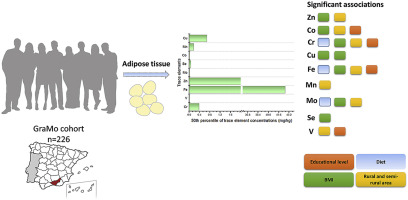Environmental Pollution ( IF 7.6 ) Pub Date : 2017-10-08 , DOI: 10.1016/j.envpol.2017.09.093 Celia Rodríguez-Pérez , Petra Vrhovnik , Beatriz González-Alzaga , Mariana F. Fernández , Piedad Martin-Olmedo , Nicolás Olea , Željka Fiket , Goran Kniewald , Juan P. Arrebola

|
There is increasing evidence linking levels of trace elements (TEs) in adipose tissue with certain chronic conditions (e.g., diabetes or obesity). The objectives of this study were to assess concentrations of a selection of nine essential and possibly-essential TEs in adipose tissue samples from an adult cohort and to explore their socio-demographic, dietary, and lifestyle determinants. Adipose tissue samples were intraoperatively collected from 226 volunteers recruited in two public hospitals from Granada province. Trace elements (Co, Cr, Cu, Fe, Mn, Mo, Se, V, and Zn) were analyzed in adipose tissue by high-resolution inductively coupled plasma mass spectrometry (HR-ICP-MS). Data were collected on socio-demographic characteristics, lifestyle, diet, and health status by face-to-face interview. Predictors of TE concentrations were assessed by using multivariable linear and logistic regression. All TEs were detected in all samples with the exception of Se (53.50%). Iron, zinc, and copper showed the highest concentrations (42.60 mg/kg, 9.80 mg/kg, and 0.68 mg/kg, respectively). Diet was the main predictor of Cr, Fe, Mo, and Se concentrations. Body mass index was negatively associated with all TEs (β coefficients = −0.018 to −0.593, p = 0.001–0.090) except for Mn and V. Age showed a borderline-significant positive correlation with Cu (β = 0.004, p = 0.089). Residence in a rural or semi-rural area was associated with increased Co, Cr, Fe, Mo, Mn, V and Zn concentrations and with β coefficients ranging from 0.196 to 0.544 (p < 0.05). Furthermore, individuals with higher educational level showed increased Cr, Co, Fe and V concentrations (β coefficients = 0.276–0.368, p = 0.022–0.071). This is the first report on the distribution of these TEs in adipose tissue and on their determinants in a human cohort and might serve as an initial step in the elucidation of their clinical relevance.
中文翻译:

成年人群脂肪组织中必需和可能必需微量元素水平的社会人口统计学,生活方式和饮食决定因素
越来越多的证据表明,脂肪组织中微量元素(TEs)的水平与某些慢性病(例如糖尿病或肥胖症)相关。这项研究的目的是评估成年人群的脂肪组织样本中选择的9种必要的和可能必要的TEs的浓度,并探讨其社会人口统计学,饮食和生活方式的决定因素。术中从格拉纳达省两家公立医院招募的226名志愿者术中收集了脂肪组织样本。通过高分辨率电感耦合等离子体质谱法(HR-ICP-MS)分析了脂肪组织中的痕量元素(Co,Cr,Cu,Fe,Mn,Mo,Se,V和Zn)。通过面对面访谈收集了有关社会人口统计学特征,生活方式,饮食和健康状况的数据。TE浓度的预测因素通过使用多元线性和逻辑回归进行评估。除硒(53.50%)外,所有样品中均检测到所有TE。铁,锌和铜的浓度最高(分别为42.60 mg / kg,9.80 mg / kg和0.68 mg / kg)。饮食是Cr,Fe,Mo和Se含量的主要预测指标。体重指数与所有TEs呈负相关(β系数= -0.018至-0.593,p = 0.001–0.090),锰和钒除外。年龄与Cu呈临界显着正相关(β= 0.004,p = 0.089) 。居住在农村或半农村地区与Co,Cr,Fe,Mo,Mn,V和Zn浓度升高有关,β系数在0.196至0.544之间(p <0.05)。此外,受过高等教育的人的Cr,Co,铁和钒的浓度(β系数= 0.276–0.368,p = 0.022–0.071)。这是有关这些TEs在人体组织中的分布及其决定因素在人类队列中的首次报道,可能是阐明其临床相关性的第一步。











































 京公网安备 11010802027423号
京公网安备 11010802027423号